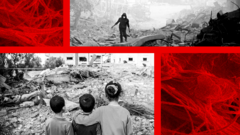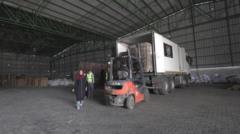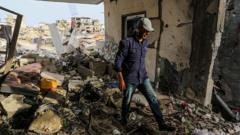With experts warning about the severe health risks posed by asbestos in Gaza's rubble, the international community is urged to address this devastating issue alongside current humanitarian efforts. The long-term ramifications of exposure to this carcinogenic material may surpass immediate dangers posed by ongoing military conflict.
Asbestos in the Aftermath: The Silent Health Hazard of Gaza's Rubble

Asbestos in the Aftermath: The Silent Health Hazard of Gaza's Rubble
The destructive military actions in Gaza have left behind not only devastation but also a looming health crisis due to asbestos contamination in the debris.
In the wake of Israel's military offensive in Gaza, a new, silent health crisis is emerging - the threat of asbestos contamination in the rubble left behind. Asbestos, a mineral known for its use in various building materials, releases harmful fibers when disturbed, posing a significant health risk that may lead to severe respiratory diseases, including lung cancer and malignant mesothelioma.
According to the United Nations Environment Programme (UNEP), up to 2.3 million tons of rubble could be tainted with asbestos across Gaza. The mineral is primarily found in roofing materials within the region's urban refugee camps, established for Palestinians displaced during the 1948-49 Arab-Israeli conflict. "The rubble in Gaza presents a very toxic environment," states Professor Bill Cookson of the National Centre for Mesothelioma Research, emphasizing the long-term health implications for future generations.
As airstrikes disturb the asbestos-containing materials, microscopic fibers become airborne, making them easily inhalable. Exposure, even in small quantities, can lead to life-threatening diseases decades later, with symptoms often appearing 20 to 60 years post-exposure. Health specialists, including Dr. Ryan Hoy, underline the challenges of avoiding asbestos exposure in Gaza, particularly given its high population density of around 2.1 million people in an area roughly one-quarter the size of London.
Currently, the ongoing military offensive overshadows concerns about asbestos risks. Chiara Lodi, a medical coordinator for Medical Aid for Palestinians, notes the community's immediate focus on survival amid the chaos, leading to a lack of awareness about the impending health threat posed by debris. Past conflicts have shown similar findings, with previous UN assessments revealing the presence of asbestos in rubble from older buildings.
Despite being banned in many countries, including Israel in 2011, certain types of asbestos still pose threats. The diversity of asbestos types—from less harmful "white" varieties to highly carcinogenic "blue" asbestos—raises further concerns. The potential for respiratory issues, exacerbated by the overall dust pollution in Gaza, illustrates the compounded health risks for residents there.
Historical comparisons, like the aftermath of the 9/11 attacks on the World Trade Center, reveal the long-term impacts of breathing toxic dust—illustrating the gravity of the asbestos situation in Gaza. Current projections suggest that the debris removal process could extend over 21 years, costing up to $1.2 billion, as highlighted by a UNEP spokesperson.
Ultimately, the international community faces pressure to manage the reconstruction and debris clearance in Gaza without further aggravating the asbestos contamination. Experts warn that addressing the health impacts of asbestos and disrupting contaminated sites requires immediate attention, as the consequences could linger far beyond the violence of war.


















